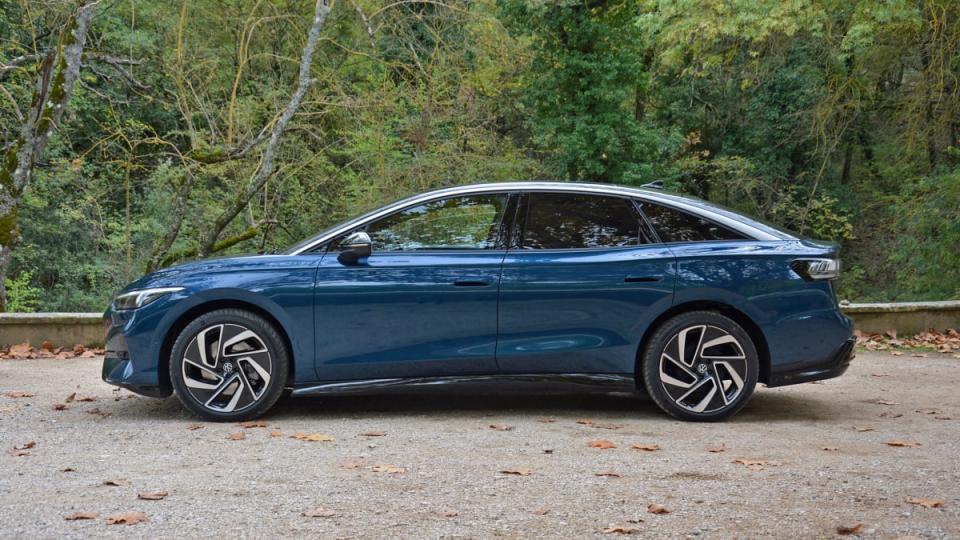Look out Tesla? Volkswagen ID.7 is a new, practical electric sedan

MANE, France – Volkswagen’s flagships have historically come in many different shapes and sizes.
In the early 1960s, the brand experimented with a big, boxy sedan powered by a rear-mounted flat-six engine closely related to the unit that powered the original Porsche 911. Known as the EA 128 internally, the model remained at the prototype stage but set a ball rolling that the stately Phaeton caught in 2002. The second-generation Phaeton was developed, tested, and ultimately canned. Volkswagen returned to the drawing board armed with a modular platform designed for electric cars to create a new flagship.
Unveiled earlier in 2023, the 2025 Volkswagen ID.7 isn’t a flagship in the Phaeton sense of the term. Its mission isn’t to ruffle BMW- and Mercedes-colored feathers; that’s still Audi’s job. It’s a Volkswagen flagship rather than a flagship Volkswagen. Coincidentally, it’s also the Wolfsburg-based company’s first electric sedan.
Adding a sedan to the range of ID-branded EVs unlocks two key advantages. First, customers in global markets now have a battery-powered alternative to the Passat (which recently went wagon-only in Europe) and, to some extent, the Arteon. Second, compared to a crossover, a sedan normally weighs less and has a lower drag coefficient, so it delivers more driving range. Engineers put a big focus on extending the time between charging stops during the development process. The ID.7 consequently boasts a drag coefficient of 0.23, a figure that places it between the BMW i4 (0.24) and the Porsche Taycan (0.22).
Visually, the ID.7 falls in line with existing members of Volkswagen’s EV line-up but it’s not a Xerox copy of, say, the ID.4. It’s also not retro like the ID.Buzz; it’s its own thing. It’s characterized by sharp-looking headlights linked by a light bar, a distinctive arch-shaped roof line with a strip of gray trim, and a rear light bar. It’s not quite a scaled-down Audi A7, but it’s more interesting looking than the last Passat.



One detail that you may not fully grasp until you see the ID.7 on the road is its size. It’s not a small car. It measures 195.3 inches long, 73.3 inches wide and 60.5 inches tall. It’s bigger in every direction than the now-retired American-market Passat, itself a very large sedan, and it’s about the same size as the new Mercedes-Benz E-Class. As with other EVs, the wheelbase stretches further than those ICE-powered sedans of similar overall length – it’s actually an inch longer than a last-generation Chevy Tahoe.
Stretching the wheelbase to SUV-like proportions gives the ID.7 an interior that’s more spacious than you might assume, even taking into account its not-so-nimble exterior dimensions. There’s plenty of space in every direction, regardless of whether you’re sitting in the front or in the back, and you can carry 18.8 cubic feet of stuff in the large trunk accessed through a massive hatch. That’s a greater volume than in the Passat. Folding down the rear bench yields 56 cubes. There isn’t a frunk, but then relatively few EVs actually have a useful frunk at this point.
Sandwiched within that wheelbase is the lone battery choice: an 82-kilowatt-hour lithium-ion pack. The range number for the U.S. market won’t be published until closer to the ID.7’s on-sale date, but the European figure checks in at 386 miles. Ours will be lower, as European numbers lean toward the optimistic side of the scale. Volkswagen claims zapping the battery pack with about 127 miles of range takes roughly 10 minutes at a 175-kilowatt charging station, though I wasn’t able to put this claim to the test.
Underpinning the ID.7 is the same MEB platform that underpins other ID Volkswagens, albeit with a new, oil-and water-cooled electric motor called AP550 that’s rated at 282 horsepower and 402 pound-feet of torque. These figures make it the most powerful motor in the Volkswagen arsenal. Rear-mounted, it spins the rear wheels via a one-speed transmission, delivers a zero-to-62-mph time of about 6.5 seconds, and unlocks a top speed of 112 mph. An all-wheel-drive variant with two electric motors will be available when the ID.7 goes on sale in 2024 (likely as a 2025 model). We might also see a 91-kilowatt-hour battery pack added sooner or later.

 Yahoo Autos
Yahoo Autos 
